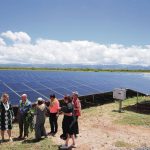William Ingenthron is passionate about solar power. But it’s not something he can add to his home — an apartment in Regina.
So he and a group of other like-minded city residents and investors got 115 solar panels put on the roof of Conexus Credit Union’s North Albert branch — and are now earning money from the renewable power they produce while offsetting emissions from Saskatchewan’s mostly fossil fuel-powered grid.
Their group is called the Wascana Solar Co-operative. It’s one of dozens of solar co-operatives across the country helping more people invest and participate in the local clean energy economy, according to a 2022 census of community energy co-operatives by researchers at the University of Victoria and University of Saskatchewan.
Proponents say they’re democratizing energy, generating investment in local solar projects and making clean energy more accessible for everyone as Canada pushes toward its goal of net-zero emissions by 2050.
What is a solar co-operative?
A co-operative is a corporation owned by members who use the corporation’s products or services.
Community energy co-operatives typically generate or invest in renewable energy, and most of those in Canada focus on solar, the census found.
Here’s how they work:
- They generate and/or invest in solar energy in their home province — often projects called “solar gardens,” which are bigger than a single home’s roof, but smaller than a solar farm.
- They sell shares in the corporation to people in the community to raise the necessary funds for the projects.
- They use the revenue from the sale of solar energy generated to pay back the investors and earn a return over time.
- Some offer additional services for members. For example, Wascana Solar Co-operative used to negotiate bulk buys of solar systems so members who had their own rooftops could get a discount on installation. It currently offers advice and consulting to members who want to install their own solar systems.
Ingenthron said the group also does a lot of public education at community events.
“Our ultimate mission is just to help foster the adoption of solar in the region,” he said.
A First Nation in Central B.C. is one step closer to having sustainable and clean energy. The Ulkatcho First Nation is set to build the largest off-grid solar power farm in Canada. CBC’s Janella Hamilton travelled to Anahim Lake to learn more about what the project means to the community.
How community solar benefits communities
Co-operatives are one way to develop projects that fall into the category of community solar, which benefits multiple people, instead of just an individual homeowner (governments, utilities and other organizations sometimes develop similar projects).

Erwin Hueck, Saskatchewan director for the Canadian Renewable Energy Association and its director of distributed energy resources, said community solar gives communities better control of their energy costs. “And the other piece here is it helps drive local investment and local participation into that energy service as well.”
That includes participation by those living in multi-unit residential buildings; those who can’t afford the upfront cost of solar or those whose location isn’t suitable for solar because of a lack of sun or other problems.
Chris Caners, general manager of Ontario-based co-op Solar Share, said community-scale projects are cheaper than individual residential installations because of economies of scale, help make the grid more resilient and reduce “line losses” that leak away power when it’s carried over long distances. He added that local benefits can encourage communities to support renewable energy projects.
Martin Boucher, a University of Saskatchewan researcher, co-authored the recent census of energy co-operatives and is the current president of the new umbrella group Community Energy Co-operative Canada.
He said co-ops are also driving innovation within the energy system.
For example, Saskatoon-based SES Solar Co-op has a system installed on the roof of a local co-housing complex. In 2020, that system started providing solar power to charge EVs owned by the Saskatoon Carshare Co-operative. The cars would otherwise be charged from the Saskatchewan grid, where 81 per cent of power is generated from fossil fuels.

This arrangement was under a “virtual net metering” agreement, where solar power produced in one location (the co-housing complex) is credited for use at other locations (the car chargers). It’s fairly new and unusual in Canada, Boucher said. (Another example is another community solar project, the Nelson Community Solar Garden in B.C.)
More money for solar
Boucher said co-ops tend to be very successful at raising money from people who are willing to take small, steady returns over a long period of time (rather than expecting big returns immediately). He added that from a government perspective, “it’s a low-cost way to actually achieve some good climate objectives.”
Solar Share was founded in 2010 and has raised more than $80 million from 2,200 members for 51 solar projects around the province, from Temiskaming to Ottawa to St. Catharines, Caners said. Together, they have 15 megawatts of capacity, generated 117 million kWh of electricity (enough to power more than 160,000 Ontario homes for a year) and earned $53 million in revenue (as of 2021, more than $7 million per year).
Solar Share’s most recent projects have been funded by selling “solar bonds” with three- to five-year terms and yields of 3.5 to 4.5 per cent annually, and Caners said it expects to be able to offer some new bonds soon.

The potential of co-ops is more apparent in Europe. A 2023 study of citizen-led energy initiatives in Europe, found more than 10,000 initiatives involving more than two million people had invested 6.2 to 11.3 billion euros ($9.1 to $16.6 billion) to install technology that would produce 7.2 to 9.9 GW of renewable energy.
In Canada in 2021, there were 97 renewable energy co-operatives in Canada (about half of which were active), down from 129 in 2015, the census found.
EU policy supports “renewable energy communities.” Boucher found policy support for co-ops is rare in Canada.
Financial regulators don’t have much experience dealing with them and vice versa.
Ingenthron said that his co-op “is kind of breaking new ground for the security exchange folks.”
That can make progress quite slow. One solar co-op that CBC News spoke to for this article has spent more five years trying to get the paperwork done with financial regulators in B.C. and has yet to announce or start raising funds for its first project.
Boucher said the census showed many of Canada’s co-operatives are isolated, volunteer-run and lack support and resources.
“A lot of boards are burnt out.” Many of those that previously existed no longer had a website at the time of the most recent census.
In response, Boucher decided to start an umbrella group to support them — Community Energy Co-operative Canada.
How governments helped in Ontario and Nova Scotia
But there are ways governments can make things easier.
Solar Share was founded in 2010, shortly after Ontario’s then-Liberal government introduced a program (now cancelled) that provided 20-year contracts for clean energy, with some contracts set aside for municipalities, Indigenous communities and co-operatives.

Caners said the certainty provided by such contracts is helpful for managing risk, especially when the high upfront cost of solar is recovered over a long period of time.
Caners said it’s more challenging to fund new projects now that the co-op has to compete for bids with big utilities.
He said if Ontario updates rules to allow virtual net metering, which it has indicated it may, that will help, as it would allow Solar Share to have customers other than the provincial government – including its own members “which is something that would be really wonderful because that’s actually something that I think our members would like.”
Virtual net metering is a key piece of Nova Scotia’s new Community Solar Program, announced earlier this year. It will allow non-profits, co-operatives, First Nations communities, municipalities, businesses, universities and colleges to build solar gardens with capacities of between 0.5 MW and 10 MW and sell subscriptions to the electricity they produce via virtual net metering.
The program sets aside 20 MW for projects under 5 MW that are developed and owned by not-for-profits, co-operatives and entities representing underserved or marginalized communities.
David Bushell, chair of Solar Nova Scotia, said previously, a solar installation in Nova Scotia couldn’t be more than 100 kilowatts (about 10 to 20 times the size of a typical single-family home rooftop system) and its power could only officially be used at the location where the solar panels were installed.
It may be one reason why the census showed there are no solar co-ops in Nova Scotia.
Bushell expects that to change, thanks to the new community solar program.
“There has been a lot of interest, and I think there’ll be a lot of exciting projects to come out of this.”
This post was originally published on 3rd party site mentioned in the title of this site





